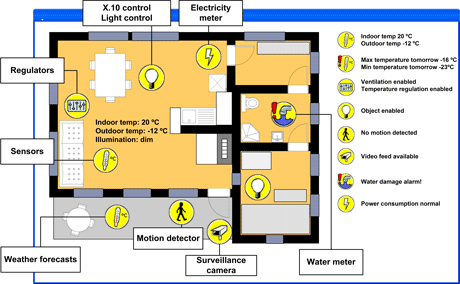by Johanna Kallio and Juhani Latvakoski
In the near future, there will be many more embedded devices than there are mobile phones. When these devices are connected to the Internet, many novel kinds of ubiquitous service will be enabled.
It has been estimated that in 2010, the number of communicating devices will be a thousand times greater than the number of mobile phones, which is already more than one billion. When connecting devices such as various machines, actuators and sensors to the Internet, novel types of service are enabled. Previously, such devices communicated with services using technology such as SMS. The applications were vendor or domain-specific closed systems, for which achieving interoperability with other vendor/domain systems was challenging. The Usenet (Ubiquitous M2M Service Networks) project aims to enable ubiquitous machine-to-machine (M2M) service networks, in which the M2M infrastructure is able to connect and combine services produced in different domains in an interoperable way (see Figure 1).

The Usenet Project
Currently, no universally applicable M2M service infrastructure exists that would allow interoperation between devices and their enabled applications in wired and wireless systems, regardless of the supplier. Information technology applications usually operate as separate M2M solutions that are unaware of each other. As a result, a number of business opportunities remain unexploited as the services provided by the devices cannot be placed on the Internet.
The three-year Usenet project funded by the Eureka/ITEA2 programme is developing a service concept for solving the above interoperability problems. M2M services refer to the services resulting from collection, transmission and processing of information, and establish an interactive system with the remote devices that are ultimately integrated within a managed M2M software system. The project has generated new types of M2M service scenario, which are related to ubiquitous building infrastructure, machine tools, consumer devices, home automation and telematics domains. The primary goal is to specify a universally applicable M2M concept that will enable the interoperation of sophisticated M2M applications through heterogeneous wired and wireless IP communication networks.
Made up of seventeen partners, the international Usenet consortium focuses on M2M research enabling ubiquitous M2M service networks. The project consortium is led by the VTT and includes industrial, SME and research partners from Finland, Belgium, France and Spain.
M2M Architecture
The system components provided by different suppliers have a strong influence on the structure of M2M systems. M2M systems usually require the integration of components coming from various stakeholders in the value chain: M2M service providers, M2M operators, M2M manufacturers, software houses and M2M system integrators. The referred components need to be interoperable in order to establish sensible business operations. Traditionally, M2M solutions have applied vertical architecture and closed solutions. This has created challenges in the distribution of added value, which has been a barrier to M2M market enlargement. It has been estimated that horizontal architecture has better possibilities to boost M2M market.
It is expected that horizontal architecture will make it easier for different players to be part of the M2M value network. For example, an M2M asset devices manufacturer can offer control and administration services for their products. Communication infrastructure can be connected to these devices by means of various telecommunications' manufacturers and service providers. Service platforms can utilize several communication infrastructures for collecting data and controlling M2M devices. Smart services can be based on information, which is collected from several service platforms. The challenges of horizontal systems are related; e.g. the overall quality of end user services and security, which inevitably requires the existence of vertical interfaces.
Home Surveillance - an M2M Application Example
A Usenet M2M application scenario has been implemented to demonstrate the Private Space M2M system for residential homes. The purpose of the system is to provide smart surveillance services of private space. Various sensors measure quantities such as humidity, temperature, light levels and consumption of water or electricity, and the space is monitored with a video camera. The user is able to follow what is happening in the system via the home user interface (Figure 2), and can control the space with sensors and actuators connected to the space. For example, users can track the outside and inside temperatures and are provided with alarms and warnings of water leaks, unexpected weather or the presence of a housebreaker. They also have control over the lights, heating and so on. Automatic services related to control operations can also be included.

Potential of M2M Systems
M2M systems will provide essential business possibilities and advantages for companies, especially when information systems controlling their core processes are utilizing the real-time information produced by an M2M system. In consequence, a company can increase the quality of its services, reduce costs and increase customer satisfaction. This fundamental change, which will bring new business opportunities for companies, can already be seen in the market. VTT aims to help companies to take advantage of this rapidly growing M2M market.
Link:
Usenet project: https://usenet.erve.vtt.fi/
Please contact:
Juhani Latvakoski, Johanna Kallio
VTT, Finland
Tel: +358 40 520 0149
E-mail: Juhani.Latvakoski![]() vtt.fi, Johanna.Kallio
vtt.fi, Johanna.Kallio![]() vtt.fi
vtt.fi










